Related Research Articles
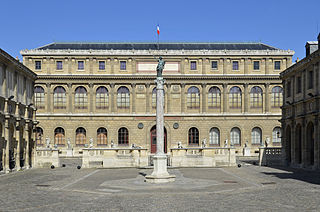
The Beaux-Arts de Paris, formally the École nationale supérieure des beaux-arts, is a French grande école whose primary mission is to provide high-level fine arts education and training. The art school, which is part of the Paris Sciences et Lettres University, is located on two sites: Saint-Germain-des-Prés in Paris, and Saint-Ouen.
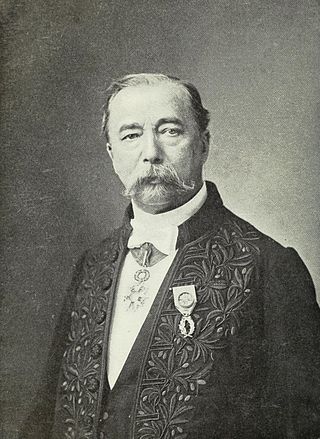
Jules Joseph Lefebvre was a French painter, educator and theorist.
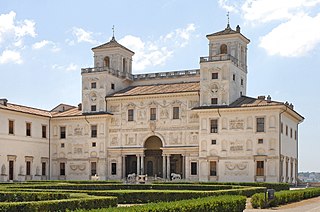
The French Academy in Rome is an academy located in the Villa Medici, within the Villa Borghese, on the Pincio in Rome, Italy.

Jean Delville, born Jean Libert, was a Belgian symbolist painter, author, poet, polemicist, teacher, and Theosophist. Delville was the leading exponent of the Belgian Idealist movement in art during the 1890s. He held, throughout his life, the belief that art should be the expression of a higher spiritual truth and that it should be based on the principle of Ideal, or spiritual Beauty. He executed a great number of paintings during his active career from 1887 to the end of the second World War expressing his Idealist aesthetic. Delville was trained at the Académie des Beaux-arts in Brussels and proved to be a highly precocious student, winning most of the prestigious competition prizes at the Academy while still a young student. He later won the Belgian Prix de Rome which allowed him to travel to Rome and Florence and study at first hand the works of the artists of the Renaissance. During his time in Italy he created his celebrated masterpiece L'Ecole de Platon (1898), which stands as a visual summary of his Idealist aesthetic which he promoted during the 1890s in his writings, poetry and exhibitions societies, notably the Salons d'Art Idéaliste.

Antoine Joseph Wiertz was a Belgian painter, sculptor, lithographer and art writer. He is known for his religious, historical, and allegorical works and portraits. He was an eccentric figure who originally was much influenced by the works of Peter Paul Rubens and Michelangelo. Some of his works are erotic and macabre and presage Belgian Symbolism. While snubbed by contemporary art critics, he enjoyed the support of the new Belgian state, which in return for his paintings assisted him in building his personal studio/home in Brussels, where the artist worked on his art and writings as a recluse.
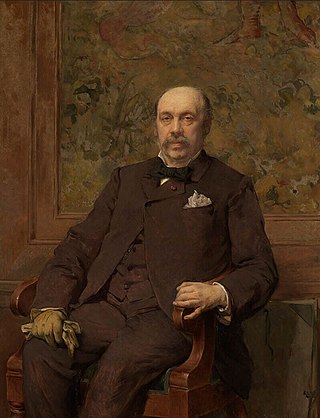
Jean-François Portaels or Jan Portaels was a Belgian painter of genre scenes, biblical stories, landscapes, portraits and orientalist subjects. He was also a teacher and director of the Academy of Fine Arts of Ghent and the Académie Royale des Beaux-Arts in Brussels. He is regarded as the founder of the Belgian Orientalist school. He was praised in his time as the premier painter of 'everyday elegance and feminine grace'. Through his art, teaching and his leadership of the Académie Royale in Brussels he exerted an important influence on the next generation of Belgian artists, including his pupil Théo van Rysselberghe.

Louis Gallait was a Belgian painter. He lay at the basis of a revival of history painting in Belgium. He earned his reputation especially with the large painting of Charles V's abdication. Gallait's works were esteemed because of their realism, faithfulness of the costumes and color composition of his paintings. He was also a distinguished portrait painter.

Charles de Wailly was a French architect and urbanist, and furniture designer, one of the principals in the Neoclassical revival of the Antique. His major work was the Théâtre de l'Odéon for the Comédie-Française (1779–82). In his designs, de Wailly showed a predilection for the perfect figure, the circle.

Michel Martin Drolling was a neoclassic French painter noted especially as a painter of history and portraitist.

Jan Verhas or Jan Frans Verhas was a Belgian painter of the Realist school. He was known for his portraits and genre paintings often depicting children of the Belgian bourgeoisie. Jan Verhas also painted history paintings, coastal landscapes, beach scenes, seascapes and the occasional still life of flowers. He was an important representative of the Realist movement in Belgium.
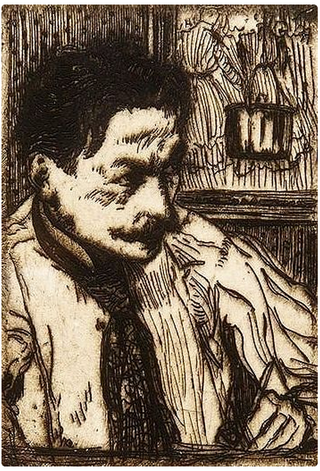
Henri-Jacques-Edouard Evenepoel was a French-born Belgian artist whose most important works are associated with Fauvism.

Nestor Cambier (1879–1957) was a Belgian artist and draftsman whose portraits were compared favourably with those of John Singer Sargent but who now is largely forgotten. He also painted landscapes, city and interior views, still-lives, murals and stained glass, and also produced numerous pencil and chalk drawings.

Jules Lagae was a Belgian sculptor and medallist, born in Roeselare.

Ferdinand de Braekeleer, sometimes spelled as Ferdinand de Braeckeleer, was a Flemish painter and printmaker. He is known for his paintings of genre scenes, church interiors, historic events, religious scenes, cityscapes, market scenes and market still lifes. He is called 'the Elder' to distinguish him from his son with the same name, who was also a painter.
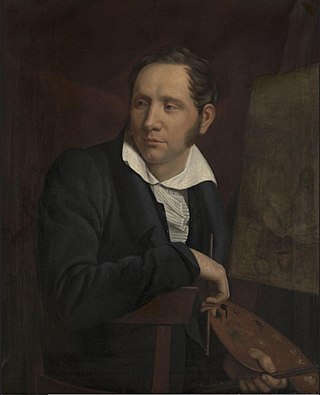
Jozef Geirnaert, also known as Jozef Lodewijk Geirnaert, Théodore-Joseph-Louis Geirnaert and Joseph Louis Geirnaert, was a 19th-century painter and draughtsman from Belgium. He is known for his genre scenes, portraits as well as his historical, religious and mythological paintings. He was first influenced by the Neoclassical style of Jacques-Louis David and later by the version of Romanticism that was in vogue in Belgium from the 1830s.
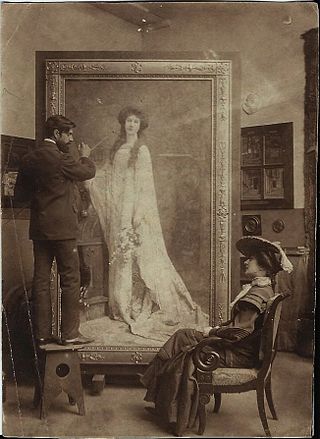
Jules Marie Auguste Leroux was a French painter and illustrator.

Elizabeth Wentworth Roberts was an American painter who lived and worked in Philadelphia, Pennsylvania, Paris, and Concord, Massachusetts. She established the Jennie Sesnan Gold Medal at the Pennsylvania Academy of the Fine Arts, where she had studied and won the Mary Smith Prize. She also studied in Paris at Académie Julian and Florence. In Massachusetts, Roberts founded and funded the Concord Art Association.

Victor Lagye was a Belgian painter and illustrator best known for his genre paintings and history scenes. He participated in various decorative programs commissioned by the Belgian government. In his later years he was active in art education.

Ernest Slingeneyer, Ernest Isidore Hubert Slingeneyer or Ernst Slingeneyer was a Belgian painter of history paintings, portraits, genre scenes and the occasional landscape. Slingeneyer is regarded as one of the last representatives of Romanticism in Belgian painting and of Academism in Romanticism in Belgian art. In his later career he was one of the leading representatives of Orientalism in Belgium. An excellent portraitist, Slingeneyer made portraits of historical figures as well as of well-known figures from his time. Slingeneyer was also a politician and was a member of the Belgian Chamber of Representatives for the Independists of Brussels, a coalition of personalities bound by their opposition to the Radicalist liberals. As a politician he promoted Academic art and agitated against new artistic currents as promoted by, amongst others, the Société Libre des Beaux-Arts in Brussels.

Léon Herbo was a Belgian painter, best known for his portraits of women in casual poses and for his portraits of actors and actresses. He also painted genre scenes, many with Orientalist themes. His wife often served as his model.
References
- 1 2 "Louis Buisseret - Biography". www.stephenongpin.com.
- 1 2 3 "Louis Buisseret Esquisses, sensibilité latine" (PDF). p. 9.
- 1 2 3 4 "Louis Buisseret - About". 1stdibs.
- ↑ "Louis Buisseret - Auction". MutualArt.